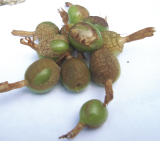
P
E
S
T
S
Thrips
Cardamom thrips are minute, fringed winged clawless greyish brown insects that breed on plant parts such as unopened leaf, spindles, leaf sheath, flower bracts and floral tubes persistently. The injured tissues from a corky layer on the capsule surface, which appear as a scabs mainly due to plant allergic reactions upon piercing by thrips. This condition is known as 'cardamom itch'(chori).
Remedy
Removal of dry drooping leaves as well as dry leaf sheaths during January-February. Timely advanced application of suitable insecticides with correct dosage.
Shoot & Capsule Borer
The catterpillars bore into the stem of seedlings, young tillers, panicles and capsules . The late stage larvae feed on the central core of the stem, affect the xylems vessels interrupting the passage of food materials to the growing parts and lead to the drying of central leaf tip known as "dead heart" symptom. In Kerala the peak of borer damage is during two periods January-February(panicle initiation) and September-October(tillering).
Remedy
Judicious application of nitrogenous fertilizers. Excess application would lead to secculent stem and increased damage by the pest. Precautionary application of suitable pesticides can control this disease.
Root Grub
The grub congregating on the root zone of cardamom clumps feed and cause irregular patch on the roots. As the pest is subterranean, damages they cause on roots may not be known until the symptom is expressed on the foliage. Two peaks of adult emergence were noticed one after the pre-monsoon rains(March-April) and another during September-October.
Remedy
Advanced and timely soil drenching of suitable chemicals will control this disease. Proper phosphatic nutrients(readily absorbable compost/vermi compost) are required for rejuvenation of cardamom root under severe incidence of root grub infestation.
White Fly
This pest of minor importance has assumed major status owing to injudicious use of insecticides and fertilizers like spraying of insecticides at shorter intervals, mixing two or more insecticides,spraying the same brand of insecticides throughout the year, spraying synthetic pyrethroids at higher concentrations than recommended dose etc. Unusual sudden rise in temperature coupled with break in monsoon showers and use of excess nitrogenous fertilizers are also the reasons for the out break. Colonies of nymphs and adults desap from the lower surface of the leaves. Chlorotic patches appear initially on leaves, which in turn become yellow and necrotic in the advanced stages.
Remedy
Judicious application of nitrogenous fertilizers. Avoid indiscriminate application of insecticides. Application of proper chemicals on the undersurface of the leaves. Spray fluid need not be applied on the panicles and cardamom stem.






